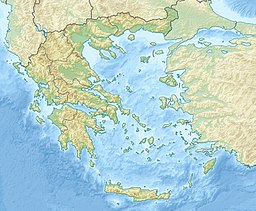Lykeion
| Lykeion | |
| Lyceum | |
| Fornlämning | |
| Land | |
|---|---|
| Region | Attika |
| Regiondel | Centrala Aten |
| Kommun | Aten |
| Höjdläge | 108 m ö.h. |
| Koordinater | 37°58′26″N 23°44′36″Ö / 37.97402°N 23.74334°Ö |
| Tidszon | EET (UTC+2) |
| - sommartid | EEST (UTC+3) |
| Geonames | 7910527 |
Läge i Grekland | |
- Uppslagsordet ”Lyceum” leder hit. För tidskriften, se Lyceum (tidskrift). För gymnasier i Finland, se Gymnasium – Finland.

Lykeion (grekiska Λύκειον, Lykeion; latin Lyceum, Lycium) var en helgedom nära Aten helgad åt Apollon, bland flera epitet känd som Apollo Lykeios. Det var även namnet på ett intilliggande gymnasium.[1] Där inrättade Aristoteles den filosofiska skolan Peripatetiska skolan år 334 f.Kr., efter Platons död. Med anledning härav har ordet i den latinska formen lyceum upptagits i de nyare språken som beteckning för en högre, universitetsförberedande skola.
Aristoteles vände sig mot den nya inriktning som Akademin (Platons skola) hade tagit. Lykeion inriktade sig mer på empirisk naturvetenskap till skillnad mot Akademins idealism, matematik och spekulation. Aristoteles flydde från Aten år 323 f.Kr., men skolan fanns kvar under olika ledare tills den romerske generalen Sulla förstörde den under sitt anfall mot Aten år 86 f.Kr.
Lämningarna efter Lykeion återfanns i dagens Aten (i sydöstra Grekland) år 1996, i en park bakom Hellenska parlamentet.
Lykeion är beläget 108 meter över havet.[2]
Skolformen lyceum
Lyceum var från 1927 års svenska läroverksreform[3] benämningen på en sorts allmänt läroverk, som fungerade som kombinerade realskolor och gymnasier. Lyceiutbildningen var en fortsättning på folkskolans sjätte klass och avsedd att leda till studentexamen. Utbildningen var sexårig och indelad i latinlyceum, reallyceum och nyspråkligt lyceum.[4]
Lyceer inrättades i Stockholm, Göteborg, Malmö, Uppsala och Lund, men blev aldrig särskilt populära, och skoltypen avskaffades på 1940-talet.[3]
Källor
- Lykeion i Nordisk familjebok (andra upplagan, 1912)
Noter
- ^ Grauls, Marcel; Swahn, Jan-Öjvind (2002). Bintje och Kalasjnikov : personerna bakom orden : en uppslagsbok (Ny utg). Bromma: Ordalaget. Libris 8418652. ISBN 9189086376. Sid. 191.
- ^ Lyceum hos Geonames.org (cc-by); post uppdaterad 2012-08-09; databasdump nerladdad 2015-05-23
- ^ [a b] Nationalencyklopedin multimedia plus, 2000 (uppslagsord Lyceum)
- ^ Svensk uppslagsbok. Band 17. Malmö. 1937. sid. 929
Se även
Externa länkar
 Wikimedia Commons har media som rör Lykeion.
Wikimedia Commons har media som rör Lykeion.- Visit Greece – Aristoteles Lyceum opens to the public
Media som används på denna webbplats
Shiny red button/marker widget. Used to mark the location of something such as a tourist attraction.
Författare/Upphovsman:
- Greece_location_map.svg: Lencer / derivative work: Uwe Dedering (talk)
Location map of Greece
Författare/Upphovsman: Carole Raddato from FRANKFURT, Germany, Licens: CC BY-SA 2.0
En 342/2 BC, Philipp King of Macedon invited the philosopher Aristotle to Mieza to tutor this 13 year old son, Alexander. Aristotle, the great thinker, scientist and philosopher who was to be hailed as the world's greatest intellectual figure was not yet particularly well known, but he enjoyed a distinguished reputation in Athens and elsewhere. The « School », as Plutarch calls it, was established in the Nymphaion, a sanctuary dedicated to the water nymphs, near the city of Mieza, in an enchanting location with luxuriant vegetation and natural springs, which is equally idyllic even today. Alexander and a select circle of students, all scions of noble Macedonian families, attended the School for two years. Her, in the shady covered walks and on the stone seats mentioned by Plutarch, the future world ruler was initiated into philosophy and poetry, mathematics and the natural sciences; and we know that he carried with him a copy of the Iliad with Aristotle had given him with a handwritten dedication until the end of his life and found it an inexhaustible source of inspiration.
In 340 BC, the 16 year old student left the School and returned to Pella in order to act as regent while his father was away in Perinthos and Byzantion. Although the School operated for such a short time, hos bond with his mentor remained strong, as did the influence of Aristotelian thought on his education, his philosophy of lief regarding ethics and politics, and the development of his personality, one of the most fascinating personalities in the ancient world.Författare/Upphovsman: Tomisti, Licens: CC BY-SA 3.0
Aristotle's Lyceum gymnasium, archaeological site in Rigillis Street, Athens.






